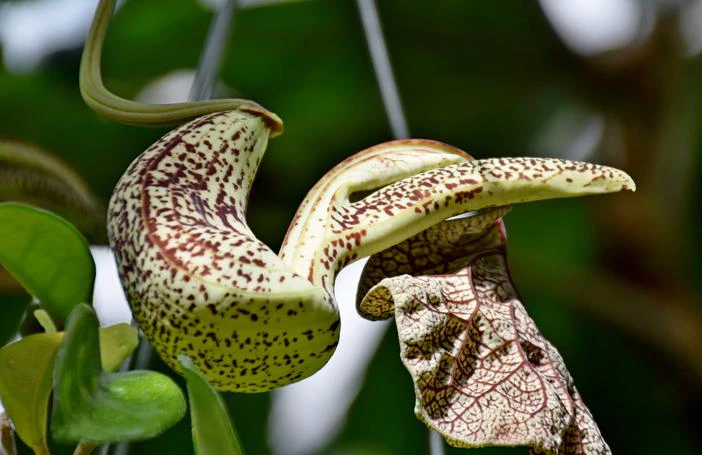Giant Pelican Flower
(Aristolochia cymbifera)
Giant Pelican Flower (Aristolochia cymbifera)
/
/

Krzysztof Golik
CC BY-SA 4.0
Image By:
Krzysztof Golik
Recorded By:
Copyright:
CC BY-SA 4.0
Copyright Notice:
Photo by: Krzysztof Golik | License Type: CC BY-SA 4.0 | License URL: https://creativecommons.org/licenses/by-sa/4.0 | Uploader: Tournasol7 | Publisher: Wikipedia Commons








Estimated Native Range
Climate Requirements
| • Precipitation | 48" - 57" |
| • High Temp. | 79°F - 88°F |
| • Low Temp. | 49°F - 60°F |
Summary
Aristolochia cymbifera, commonly known as Giant Pelican Flower, is a perennial vine native to the Atlantic Forest biome in Brazil, particularly thriving in its humid and shaded understory. It is characterized by its large, ornate flowers that can reach up to 10 inches in length, with a unique shape resembling a pelican’s pouch, and are typically a mottled yellow and purple color. These flowers emit a strong, unpleasant scent to attract pollinators such as flies. The vine also features broad, heart-shaped leaves that add to its lush appearance. Flowering occurs primarily in the summer months.
The Giant Pelican Flower is valued for its striking and unusual flowers, which make it a conversation piece in any collection. It is often grown in greenhouses and botanical gardens due to its need for a controlled, tropical environment. In cultivation, it requires consistently moist, well-drained soil, high humidity, and partial to full shade to mimic its native habitat conditions. While it is not commonly used in outdoor landscaping due to its specific requirements, it can be a spectacular addition to indoor plant displays or conservatories. Care should be taken, as all parts of the plant contain toxic compounds that can be harmful if ingested.CC BY-SA 4.0
The Giant Pelican Flower is valued for its striking and unusual flowers, which make it a conversation piece in any collection. It is often grown in greenhouses and botanical gardens due to its need for a controlled, tropical environment. In cultivation, it requires consistently moist, well-drained soil, high humidity, and partial to full shade to mimic its native habitat conditions. While it is not commonly used in outdoor landscaping due to its specific requirements, it can be a spectacular addition to indoor plant displays or conservatories. Care should be taken, as all parts of the plant contain toxic compounds that can be harmful if ingested.CC BY-SA 4.0
Plant Description
- Plant Type: Vine
- Height: 5-10 feet
- Width: 10-20 feet
- Growth Rate: Moderate
- Flower Color: Brown, Green
- Flowering Season: Summer
- Leaf Retention: Deciduous
Growth Requirements
- Sun: Part Shade
- Water: Medium
- Drainage: Medium
Common Uses
Border Plant, Butterfly Garden, Low Maintenance, Showy Flowers
Natural Habitat
Native to the humid and shaded understory of the Atlantic Forest biome in Brazil
Other Names
Common Names: Duck Flower, Pelican Flower
Scientific Names: Aristolochia cymbifera, Ambuya labiosa, Aristolochia abbreviata, Aristolochia abbreviata, Aristolochia abbreviata, Aristolochia cymbifera var. abbreviata, Aristolochia cymbifera var. abbreviata, Aristolochia cymbifera var. genuina, Aristolochia cymbifera var. labiosa
GBIF Accepted Name: Aristolochia cymbifera